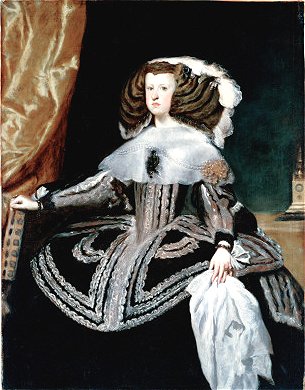 |
|
PORTRAIT OF DONA MARIANA, QUEEN OF SPAIN AS A YOUNG WOMAN
Attributed to Juan Battista Martinez del Mazo Spanish
1613-1667
SN 337 Oil on Canvas About
1652/53
by Robert Anderson
ARTIST
This Spanish painter was a pupil of Velazquez who married his daughter
in 1633 and who succeeded him as court painter in 1661. As Velazquez was promoted to
higher offices by the King he pushed or pulled Mazo along with him. One of his very few
signed works is a portrait of Queen Mariana. Many of the works attributed to him were
formerly given to Velazquez, whose mature style he imitated with distinction.
Various portraits of Mariana of Austria, by Mazo, were used as
prototypes for later portraits of the Queen by other court painters, particularly Juan
Carreno de Miranda.
Mazo's landscape paintings with small figures are personal in style and
his extraordinary ability in this genre was recognized by his contemporaries. He had great
skill in the graceful depiction of the gestures and expressions of the figures in his
landscapes.
Mazo was known to have copied the works of other artists, particularly
Rubens and Titian, with such a degree of perfection that, according to Palomino, it was
almost impossible to distinguish the copies from the originals. |
SUBJECT
Mariana, Queen of Spain, was the daughter of the Emperor Ferdinand III
and Mary of Hungary. At age fourteen (14) she became the second wife of King Philip IV of
Spain (his first wife, Isabel of Bourbon having died in 1649). Philip had been left
without an heir at forty-four, after his son Balthasar also died. Mariana bore Philip two
sons: Philip Prosper, who died at the age of four (4) and the future Carlos Segundo,
Charles II. She was known as a spendthrift whose extravagance added to the later financial
woes of the country.
Philip and Mariana's chldren were often portrayed by Velazquez, most
famously in "Las Meninas", whose central figure, the Infanta Margarita
strikingly resembles her mother.
PAINTING
Mariana is seen here in a stance known as the "Royal Portrait
Style". Age made no difference, all royal ladies stood in the same positioning. She
is dressed in a black gown with silver ornamentation over which is seen a shawl decorated
with pearls and medallions. Her right arm reaches out to a table while her left holds a
large white kerchief. Mariana wears bracelets and rings on both hands and has an elaborate
hairdo. Her young face has red cheeks but she looks rather haughty and petulant.
HISTORICAL CONTEXT
Mariana became Queen at a time when Spain was at war with both Holland
and France. Management of the country, its civil affairs and the management of the war
effort, was left in the hands of one of Philip's ministers, Don Gaspar de Guzman the Count
of Olivares. Philip, himself was much more interested in food, women, art and hunting. The
arts flourished but the country was crushed by high taxes and the defeat on land and sea
by France and Holland. After Philip's death in 1665, Mariana, as regent for her son
Charles II, left the rule of the country in the hands first of her confessor Johannes
Nithard, then under the control of her lover Fernando Valenzuela.
Decadence became the order of the day. No great literary figure
dignified the age, no great drama took the stage. The universities were languishing amid
the general destitution. Charles the half-idiot son of Philip and Mariana assumed the
government and presided helplessly over the debacle. The disintegration of Spain became a
European tragedy and by 1700 the country was signed over to the Duke of Anjou, grandson of
the French King. Charles died at the age of thirty-nine (39), the last of the Hapsburg
rulers of Spain.
ringlingdocents.org
|